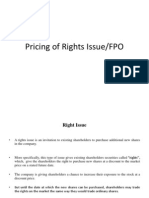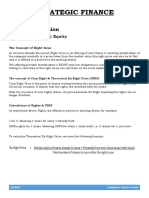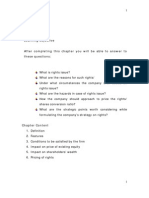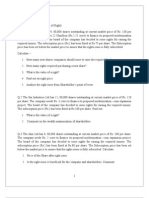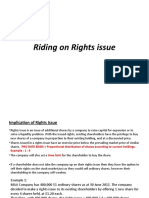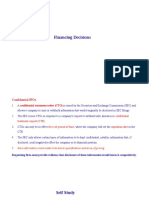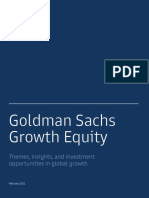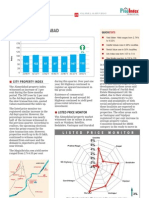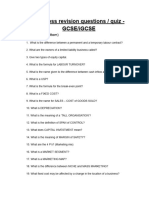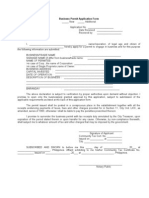EQUITY FINANCING – PROBLEM SET- SOLUTION
1. A venture capitalist (VC) who is interested in investing in a promising start-up has valued its equity
at Rs. 60 crores. The VC would like to subscribe to fresh shares of the start-up so as to get a 25%
shareholding. How much money would the VC need to invest?
Pre-money valuation = Rs. 60 crores. Post-investment stake of the VC = 25%.
Therefore, Rs. 60 crores relates to 75% of the post-money valuation. Therefore, post-money valuation
= Rs. 80 crores. Therefore, for a post-investment stake of 25%, VC would invest Rs. 20 crores.
2. A company has 300 equity shares outstanding (paid-up capital of Rs. 300,000) and wants to raise
fresh capital to fund new projects. A new shareholder invests Rs. 40,000 for a 12.5 per cent equity
stake in the company. What is the post-money valuation of the company’s equity?
Post-money valuation = Fresh investment/ Stake corresponding to fresh investment = Rs. 40,000/
12.5% = Rs. 320,000
3. An entrepreneur starts a company by investing Rs. 1 crore from his own savings for 100,000 shares.
A year later, VC1 invests Rs. 1 crore in the company and subscribes to a 10% stake. Another year
later, VC2 invests Rs. 10 crore and subscribes to a 10% stake.
At this stage, what are the shareholding percentages of each of the three shareholders in the company?
At this stage, what are the values of the stakes held by each of the three shareholders in the company?
Recall the Marvin example.
Stage 1: Entrepreneur invests Rs. 1 crore and the company issues him 100,000 shares. At this stage,
s/he holds a 100% stake.
Stage 2: VC1 invests Rs. 1 crore. The company issues VC1 enough shares so that VC1 holds 10%
post-investment. If number of shares issued = x, x/(x+100,000) = 10% => x = 11,111 shares
Stage 3: VC2 invests Rs. 10 crore. The company issues VC2 enough shares so that VC2 holds 10%
post-investment. If number of shares issued = y, y/(y+111,111) = 10% => y = 12,346 shares
Post Stage 3, total number of shares = 123,457. Entrepreneur holds 100,000 shares i.e. 81%, VC1
holds 11,111 shares i.e. 9% and VC2 holds 12,346 shares i.e. 10%. If 10% is worth Rs. 10 crore
(amount invested by VC2), value of Entrepreneur’s stake is Rs. 81 crore, and value of VC1’s stake
is Rs. 9 crore.
�4. A company has 1,000,000 shares outstanding. It wishes to issue 200,000 new shares using a rights
issue. If the current stock price is Rs. 30 and the rights offer price is Rs. 20 per share, calculate the
value of the right to purchase one new share under the rights offer. Also, what would the stock price
(theoretically) be after the rights issue?
Market capitalisation of the firm after the issue = (1 mn x Rs. 30 + 0.2 mn x Rs. 20) = Rs. 34 million
Number of shares outstanding after the issue = 1 mn + 0.2 mn = 1.2 million
Therefore, assuming the rights issue does not communicate any additional information to investors ,
expected share price after issue = 34/1.2 = Rs. 28.33
Therefore, value of right to purchase one share = Rs. 28.33 – Rs. 20 = Rs. 8.33
5. A company’s stock price is currently Rs. 75 per share. The company proposes a rights issue at a
price of Rs. 65 per share but does not want the stock price after completion of the rights issue to be
below Rs. 69 per share. Assuming no other effects of the rights issue announcement on the current
stock price, what is the maximum entitlement ratio the company can have for the rights issue?
Suppose for every share held, the shareholder gets the right to subscribe to “x” new shares. Thus,
the shareholder currently holds a share worth Rs. 75 and pays Rs. 65 per share for x new shares.
Post the rights issue, the stock price would settle at (75 + 65x)/ (1 + x). Equating the above to Rs.
69 and solving for x, we get x = 1.5, or 3 shares for every 2 shares held.
6. A company has 25 crore equity shares outstanding. Its stock price is Rs. 60 per share. The expected
return on equity of the company is 15%. The company proposes a preferential issue of 15 crore shares
to an investor at a price of Rs. 70 per share. What would the stock price (theoretically) be after the
preferential issue?
Market capitalisation of the firm after the issue = (25 cr x Rs. 60 + 15 cr x Rs. 70) = Rs. 2550 crore
Number of shares outstanding after the issue = 25 cr + 15 cr = 40 cr
Therefore, assuming the preferential issue does not communicate any additional information to
investors, expected share price after issue = 2550/ 40 = Rs. 63.75
7. The XYZ Company Limited made a rights issue of one new share for every four shares held at
Rs.40 per share. Before the issue, there were 10 million shares outstanding and the share price was
Rs. 50.
a) What was the prospective stock price after the issue?
b) The rights issue gives the shareholder the opportunity to buy new shares for less than the
market price. What was the value of the opportunity to subscribe to one such share?
c) Suppose that the company had decided to issue new stock at Rs. 30 rather than Rs. 40. How
many new shares would it have needed to sell to raise the same sum of money?
The market capitalisation of the firm before the rights issue is 10 million shares * Rs. 50 per
share i.e. Rs. 500 million.
Due to the rights issue, the equity value of the firm would increase by 2.5 million shares * Rs. 40
per share i.e. Rs. 100 million.
So, the post-issue market capitalisation would be Rs. 600 million which would be spread over
12.5 million shares.
� Therefore, the post issue price would be Rs. 600 million/ 12.5 million shares = Rs. 48 per share.
So, the value of the right to purchase one new share would be Rs. 48 – Rs. 40 = Rs. 8.
If the issue were at Rs. 30 per share, the company would need to issue Rs. 100 million/ Rs. 30 =
3.33 million shares
8. If the stock price before the rights issue was Rs. 100 per share, the price after the rights issue is Rs.
98 per share, and the entitlement under the rights issue was to subscribe to 1 share for every 5
shares held, then what was the value of the right to subscribe to 1 share?
Stock price before rights issue= Rs. 100 per share
Stock price after rights issue= Rs. 98 per share
Before the rights issue, value of 5 shares = 5 shares * Rs. 100 per share = Rs. 500
After the rights issue, value of 6 shares = 6 shares * Rs. 98 per share = Rs. 588
Thus, (theoretically) the rights issue must have been at Rs. 588 - Rs. 500 = Rs. 88 per share
The value of the right to subscribe to 1 share = Rs.98 - Rs.88 = Rs.10
�9. Three friends start a business by pooling in Rs. 200,000; and they award themselves a total of 200,000
shares in the business.
Three months later they need Rs. 900,000 more to continue their R&D on the idea. They are able to
raise this in their first round of external funding at Rs. 3 per share from VC Firm X. What share of
the business is owned by the founders now? How much is this stake worth?
Six months after their first round of funding they need a further Rs. 1,000,000 to build a prototype.
At this stage, they are able to raise Rs. 500,000 from VC Firm X and another Rs. 500,000 from VC
Firm Y. However, they are able to raise this second round of external funding, only at Rs. 2 per share.
What share of the business is owned by (i) the founders, (ii) VC Firm X, and (iii) VC Firm Y now?
How much is each of these stakes worth?
Initial funding VC Funding Stage 1 VC Funding Stage 2
Shareholder No. of shares % stake No. of shares % No. of shares %
(Value in Rs.) (Value in Rs.) stake (Value in Rs.) stake
Founders 200,000 100% 200,000 40% 200,000 20%
(200,000) (600,000) (400,000)
VC X - - 300,000 60% 300,000 + Rs. 55%
(900,000) 500,000/ Rs. 2
per share =
550,000
(1,100,000)
VC Y - - - - Rs. 500,000/ 25%
Rs. 2 per
share =
250,000
(500,000)
Pre-money 0 200,000 X 3 = 600,000 500,000 existing shares
valuation (Rs.) x Rs. 2 per share =
1,000,000
Investment 200,000 900,000 (Given) 1,000,000 (Given)
(Rs.)
Post-money 200,000 600,000 + 900,000 = 1,000,000 + 1,000,000
valuation (Rs.) 1,500,000 = 2,000,000
Shares issued 200,000 900,000/3 = 300,000 1,000,000/2 = 500,000
Issue price 1 3 (Given) 2 (Given)
(Rs.)
Total shares 200,000 200,000 + 300,000 = 500,000 + 500,000 =
500,000 1,000,000
